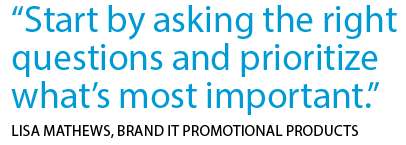May 19, 2017
How to Market Products for a Wide Target Audience
Promotional experts give their best tips.
Creating and executing a promotional product strategy for a client with a varied target audience can be a challenge. There are numerous ages, ethnicities and genders to take into consideration, plus geographical differences and subtle nuances in taste, not to mention substantial product quantities kept within budget constraints. We talked to two promotional product experts who offer their advice for meeting the needs of a large group of people and looking like a rock star to the end-buyer.

Mark Herman, regional manager at American Solutions for Business (asi/120075) in Boston
1. Know Their Marketing Intentions
“You have to start with understanding their goals and objectives for the campaign or event. This is a people business, and everything is directed at people, so look at the makeup of the target audience: What demographics are represented? Is it segmented at all? This lays the foundation and then you can discuss in further detail. What products would fit? What’s your client’s budget? What type of reaction are you looking for? You want it to go full circle so it meets both the campaign or event goals and the company’s goals.”
2. Leverage Your Resources
“The merchandising team at your vendor companies can fine-tune the objectives and tap into their product knowledge to create a finite grouping of items. Consider tiered solutions for a stepped approach and go through a process of elimination with the client. Remind them that it’s not one-and-done, and it’s not all-encompassing when you first start out. There might be two or three iterations before you get where you want to be.
3. Consider Tech Accessories
“One no-brainer category is technology, including Bluetooth speakers, headphones and power decks. They’re versatile and you can present them in different ways. They’re very manageable budget-wise. I saw a lot of tech at a recent trade show, so it’s clear that our partners are providing these products. Price points aren’t outrageous, and for promo products in particular, overall cost of an order drives huge value. It’s also about packaging, packaging, packaging. When it’s presented well, you not only promote the value you bring, but you also defuse budgetary constraints when they see what they’re getting.”

Lisa Mathews, owner of Brand It Promotional Products (asi/243344) in Spokane, WA
1. Create a List of Priorities
“Start by asking the right questions and prioritize what’s most important. What’s the event? What does the target market look like? It’s really a templated process. I listen, and I make suggestions. They might also come up with things I wouldn’t have thought of. I help them by presenting just a few items. I listen to what they say when we’re first brainstorming and then I go from there. I have them tell me the styles they like, and I try not to think too much for them.”
2. Be Familiar With Current Trends
“Be proactive and make sure the suggestions are targeted. You have to be very in-tune with the time of year and what’s going on in their specific market at a given time. You have to know what products are trending and the seasons that are coming up. It’s all cyclical, so we can stay proactive. I also don’t want to compete on price, but I need to be accurate with them about what’s possible for their budget. If you’re consistent and you don’t let them down, they’re in your list forever. I’m up 168% in sales over last January, and we’re updating our database hourly.”
3. Stick to Staple Products
“Drinkware is versatile and super-universal. I sell it to school districts, hospitals, dentists and others. Now people are willing to spend more on different types and styles. It used to be they didn’t want to spend more than $3, then it increased to $5, now it’s $12 and up since people see Yeti tumblers for $30 at REI and they say, ‘Wow, I can get a similar tumbler with my logo on it for just $12!’ Writing instruments, hats and mugs are universal too. Pens, for example, are the starting point for many of our long-term client relationships.”
Read This
Cash Nickerson taps into his business expertise and 30 years of martial arts instruction to offer tips on how intelligent listening can lead to more sales and stronger client relationships.
